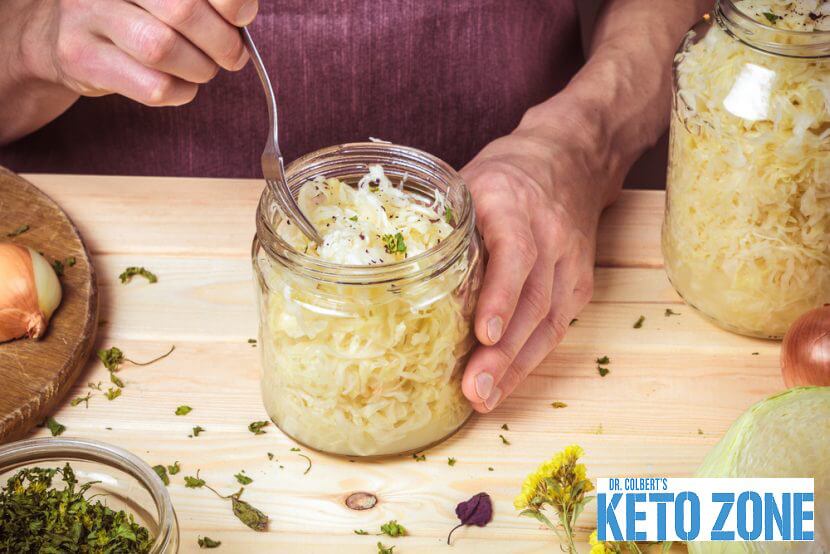Do you get enough probiotics on the Keto Zone Diet?
Probiotics are healthy bacteria that reside in your large intestine and help you break down food, modulate the immune system, and regulate your neurochemistry. The community of bacteria in your body is referred to as the microbiome.
These bacteria are so important that many people regularly supplement with probiotics in order to keep the microbiome healthy.
But this is nothing new!
People have been getting probiotic bacteria through eating fermented food for many generations. Fermentation is a traditional preservation method used to store perishable vegetables after the growing season for consumption throughout the winter.
One of the most common fermented foods is sauerkraut. You can find many brands of sauerkraut in grocery stores everywhere. However, the unfortunate truth is most of these commercial sauerkrauts have been pasteurized which removes the beneficial probiotic bacteria.
That is why we are sharing this simple sauerkraut recipe. It can be made at home with only 2 ingredients so you can get all of the great benefits of probiotics!
INGREDIENTS
5 pounds organic green cabbage
3 tablespoons sea salt
INSTRUCTIONS
- Start by cleaning your supplies! Since this is a fermentation project, we want to sanitize everything to be sure that we only grow healthy probiotic bacteria!
- You will need a large bowl, 5-6 quart glass mason jar (or multiple smaller jars), and a spoon. Wash them thoroughly making sure no soapy residue remains that may kill your probiotic bacteria.
- Remove the tough outer layers of your cabbage and set aside.
- Remove another 4-6 leaves of cabbage and set aside for later.
- Slice 1/3 of your cabbage in to thin slices and place in a large bowl.
- Add 1 tablespoon of salt to the bowl and begin to knead the cabbage with your (clean) hands until it begins to release moisture.
- Slice the next 1/3 of your cabbage and add to the bowl.
- Add another tablespoon of salt and knead until moisture begins to release.
- Finish slicing the final 1/3 of cabbage and repeat.
- Continue to knead the cabbage until a salt brine begins to form in the bowl.
- Now you can transfer your sauerkraut in to your jar(s).
- Use a spoon to firmly pack the cabbage in to jar until the brine covers the cabbage, add a small amount of spring water and some extra salt if necessary to submerge the cabbage.
- Take the cabbage leaves you set aside and fold them so that they fit in to the mouth of the jar.
- Stack folded cabbage leaves on top of the sauerkraut to ensure that the shredded cabbage remains submerged under the brine.
- This is important because sauerkraut relies on anaerobic fermentation which means that no oxygen can be present.
- Cover the jar and place in a cool dark cupboard or closet to ferment for 2-3 weeks.
- Check your sauerkraut every few days to make sure the cabbage is still submerged in the brine. If not, open the jar and firmly press the cabbage back down and add more salt water if necessary.
- Once the sauerkraut has finished fermenting it can be refrigerated for up to 6 months.
- Enjoy!
NUTRITION FACTS
Serving Size: 1/4 cup
Per serving:
Calories: 14 kcal
Fat: 0 g
Total Carbs: 3 g
Fiber: 2 g
Net Carbs: 1 g
Protein: 1 g

Leave a Reply